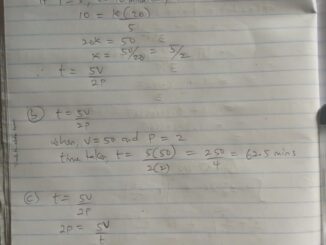Welcome to “Naijaclass Academy” For Waec 2024 Islamic Studies Answer
Date: Wednesday, 5th June, 2024
IRS (Essay & Objective) 9:30 am – 12:30 pm
——————————
IRS OBJ
01-10: CDBDBACCCC1
1-20: CCCDBACCCB
21-30: ACCBABADAC
31-40: ACACADBBAA
41-50: BACBCDDCBD
COMPLETED
(1)
After the death of Prophet Muhammad the Muslim community was faced with the challenge of preserving the Qur’an which had been revealed to the Prophet over a period of 23 years. During the Prophet’s life, the verses were memorized verbatim by his companions, and some were also written down on various materials such as parchment, bone, and leaves. However, the primary mode of preservation was through memorization.
The need for compilation became apparent after the Battle of Yamama where many Muslims who had memorized the Qur’an were martyred. Concerned about the potential loss of the Qur’an, Caliph Abu Bakr ordered the collection of the revelations into a single, authoritative manuscript. He entrusted this task to Zaid ibn Thabit, a former scribe of the Prophet who was known for his meticulousness and had memorized the Qur’an himself.
Zaid approached this monumental task with caution. He set up strict criteria for the collection process: each verse had to be verified by two witnesses who had heard it directly from the Prophet, and he cross-referenced the oral recitations with the written fragments. This way, Zaid ensured the accuracy and authenticity of the compilation.
The result was a single, compiled volume of the Qur’an, ordered according to the instructions that Prophet Muhammad (PBUH) had given during his lifetime, as the Prophet had overseen the arrangement of verses and chapters (Surahs) when they were revealed. This compiled manuscript was kept with the Caliph Abu Bakr, and after his death, it was passed on to the next Caliph, Umar ibn al-Khattab, and then to his daughter, Hafsa bint Umar, who was one of the Prophet’s widows and a trusted guardian of the manuscript.
Later, during the caliphate of Uthman ibn Affan, due to the rapid expansion of the Islamic empire and the variations in recitation that began to spread in different regions, a decision was made to standardize the Qur’an text. Uthman ordered the preparation of several copies of the original manuscript compiled during Abu Bakr’s time, which were then sent to various Islamic centers of the empire. He also instituted the writing down of the Qur’an in the Quraishi dialect, the dialect of the Prophet.
This standardized version of the Qur’an, known as the Uthmanic codex, is the one that has been used by Muslims around the world ever since, and it has been preserved with remarkable consistency across the centuries. The process of compilation ensured that the Qur’an remained authentic to the revelations received by the Prophet, safeguarding it for future generations.
=================================
(2a)
The term Sunnah refers to the sayings, actions, and approvals of the Prophet Muhammad (S A.W) that were documented and passed down by his companions and their followers. It includes his teachings, guidance, and examples of how he lived his life, which serve as a model for Muslims to follow.
(2b)
(i)Authentic chain of narrators: A sound Hadith has a continuous and unbroken chain of narrators, each of whom is known for their integrity and accuracy.
(ii)Reliable narrators: The narrators in the chain must be known for their truthfulness, trustworthiness, and knowledge.
(iii)Clear and unambiguous text: The text of the Hadith must be clear and unambiguous, without any contradictions or doubts.
(iv)Free from contradictions: A sound Hadith does not contradict the Quran, other established Hadiths, or established historical facts.
(v)Free from errors: The Hadith must be free from errors in grammar, syntax, and language.
(vi)Confirmed by multiple narrations: A sound Hadith is confirmed by multiple narrations from different narrators.
(vii)Not contrary to reason or intellect: A sound Hadith must not be contrary to reason or intellect, and must be in line with the general principles of Islam.
(viii)Not in conflict with historical facts: A sound Hadith must not be in conflict with established historical facts and must be in line with the context in which it was narrated.
==============================
(3)
(i)Time: The prayer is performed in the morning, after sunrise, on the 10th day of the Islamic month of Dhu al-Hijjah.
(ii)Congregation: Muslims gather in a large congregation, usually in a mosque or an outdoor area, to perform the prayer.
(iii)Preparation: Before the prayer, Muslims:
– Take a bath or shower (ghusl)
– Wear new or clean clothes
– Apply perfume or fragrance
– Bring a sacrificial animal (if possible)
(iv)Prayer:
– The Imam leads the congregation in two rak’ahs (units) of prayer
– The prayer includes specific supplications and recitations
– Muslims face the Ka’bah in Makkah during the prayer
(v)Khutbah_: After the prayer, the Imam delivers a sermon (khutbah), which includes:
– Praise and gratitude to Allah
– The story of Prophet Ibrahim (Abraham) and his willingness to sacrifice his son
– The importance of obedience, sacrifice, and generosity
– Congratulations and blessings for the congregation
(vi)Sacrifice: After the prayer and khutbah, Muslims who have the means sacrifice an animal (usually a sheep, goat, or cow) to commemorate Prophet Ibrahim’s willingness to sacrifice his son. The meat is then distributed to the poor and needy.
(vii)Celebration: The rest of the day is spent with family and friends, exchanging gifts, sharing meals, and celebrating the occasion.
====================================
NUMBER 4
(6a)
Bismillaahir Rahmaanir Raheem
(i)Innaa anzalnaahu fee lailatil qadr
(ii)Wa maa adraaka ma lailatul qadr
(iii)Lailatul qadri khairum min alfee shahr
(iv)Tanaz zalul malaa-ikatu war roohu feeha bi izni-rab bihim min kulli amr
(v)Salaamun hiya hattaa mat la’il fajr
(6b)
In the Name of Allah, The Most Gracious, Most Merciful
(i)Verily! We have sent it (this Qur’an) down in the night of Al-Qadr (Decree)
(ii)And what will make you know what the night of Al-Qadr (Decree) is?
(iii)The night of Al-Qadr (Decree) is better than a thousand months (i.e. worshipping Allah in that night is better than worshipping Him a thousand months, i.e. 83 years and 4 months).
(iv)Therein descend the angels and the Ruh [Jibrael (Gabriel)] by Allah’s Permission with all Decrees,
(v)Peace! (All that night, there is Peace and Goodness from Allah to His believing slaves) until the appearance of dawn.
(6c)
(i).Quran 97, titled “Al-Qadr” or “The Decree,” discusses the night of decree, which is believed to occur during the month of Ramadan, highlighting its significance in Islamic belief and practice.
(ii)This chapter emphasizes the profound importance of the night of decree, describing it as better than a thousand months, symbolizing the immense blessings and spiritual opportunities it offers to believers.
(iii)Quran 97 encourages believers to engage in worship, reflection, and supplication during the night of decree, as it is a time when divine mercy and guidance are particularly abundant.
(iv)The chapter underscores the concept of predestination (Qadr) in Islam, affirming that Allah’s decree is absolute and encompasses all aspects of existence, including human destiny and the unfolding of events.
(v)Through Quran 97, Muslims are reminded of the transformative power of faith, prayer, and devotion, especially during moments of spiritual significance such as the night of decree, which serves as a source of hope, inspiration, and renewal for believers.
=====================================================================
*ISLAMIC STUDIES*
(5a)
The Battle of Uhud was a significant military encounter that took place on March 23, 625 AD (7 Shawwal, 3 AH in the Islamic calendar) in the valley north of Mount Uhud, near Medina. It was fought between the early Muslim community led by Prophet Muhammad (PBUH) and the Quraysh tribe of Mecca, who sought revenge for their defeat at the Battle of Badr a year earlier.
(5b)
(i)Formation of armies: The Muslim army, consisting of around 700 fighters, positioned themselves at the foot of Mount Uhud, while the Quraysh army, numbering around 3,000 men, faced them.
(ii)Initial attack: The battle commenced with a fierce attack from the Quraysh, who were met with a strong resistance by the Muslims. The Muslim archers, placed on a nearby hill, initially held their ground and inflicted significant damage on the enemy.
(iii)Abandonment of strategic positions: However, the Muslim archers abandoned their strategic positions on the hill, against the Prophet’s orders, in pursuit of war spoils, leaving the Muslim army vulnerable to attack.
(iv)Counterattack by the Quraysh: The Quraysh cavalry, led by Khalid ibn al-Walid, seized the opportunity and launched a surprise attack on the Muslims from the rear. The Muslim army suffered heavy casualties and retreated, marking a temporary victory for the Quraysh.
(v)Aftermath: Despite their initial victory, the Quraysh failed to capitalize on their success and did not launch a subsequent attack on Medina. The Muslims were able to regroup and recover from their losses, which ultimately strengthened their resolve and unity.
=====================================================================




Theory for irs weac for 2024
This so good